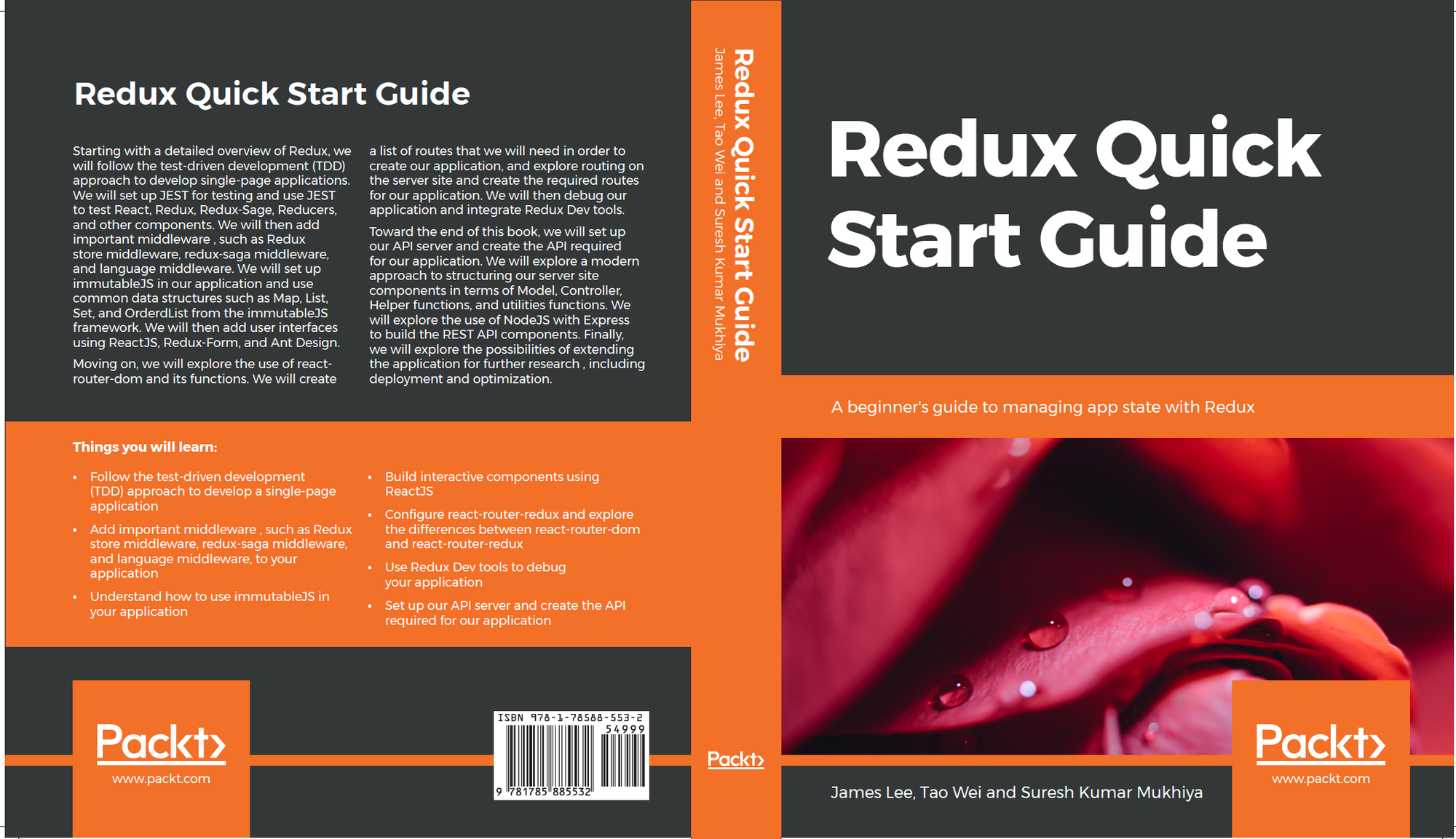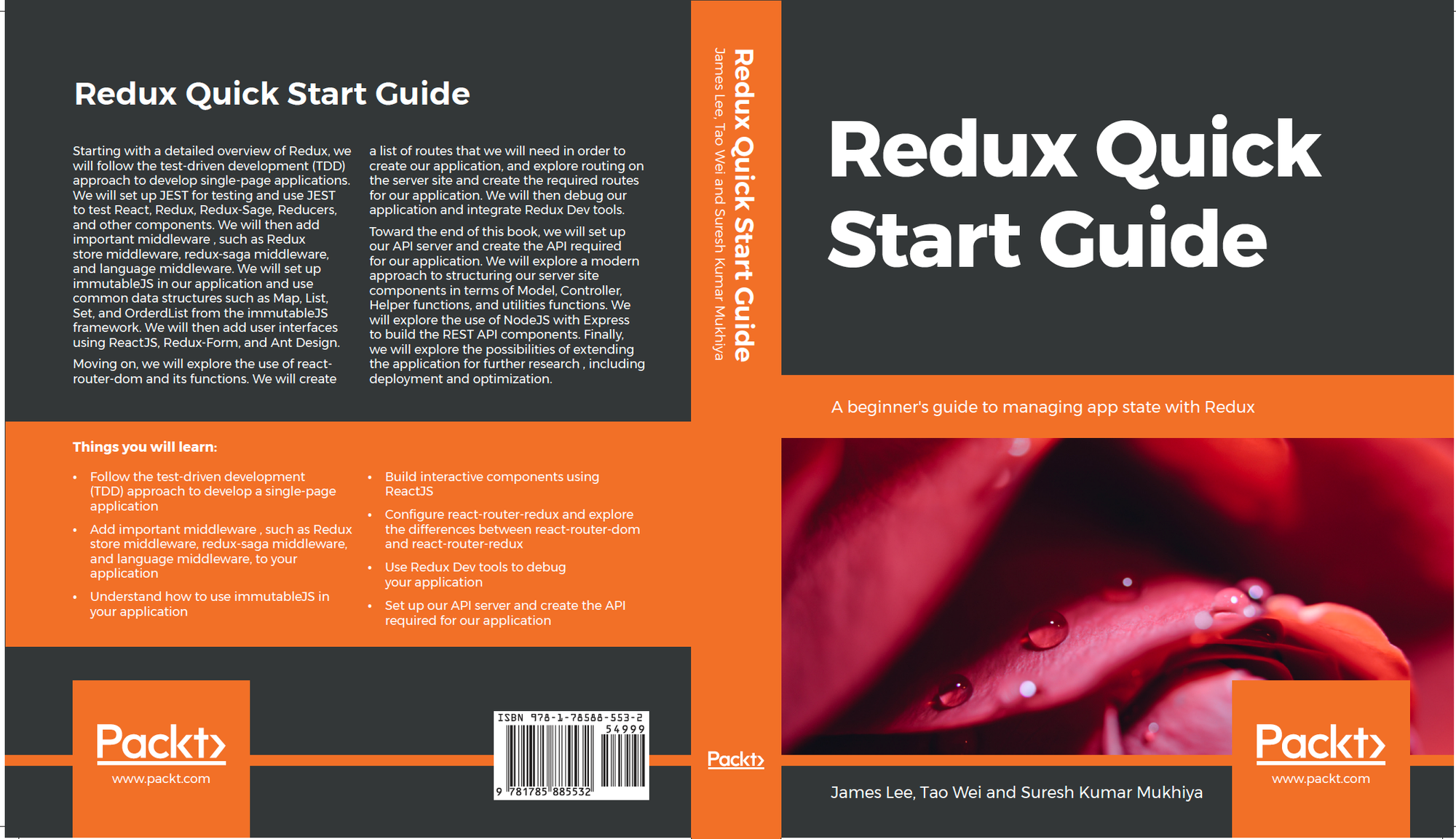Preface
This book explores methodologies for developing a scalable modern web application using cutting edge front-end technologies. The book is intended for web developers, frontend developers and beginner programmers who want to use React and Redux to develop a modern web application. In this book, We will show you how you can integrate Redux with
React and other front end JavaScript frameworks efficiently and manage application states effectively. Finally, we will explore the architecture of Redux-Saga and see how saga can be used in handling side effects.Redux Quick Start Guide

We will follow the
TDD (Test Driven Development) paradigm in this book where we test each piece of code we develop. We will use the JEST framework for testing. In addition to that, we will learn about advanced debugging techniques using Redux Dev tools. In this book, we will build a simple multi-lingual simple Hospital Management System to perform CRUD (Create, Read, Update and Delete) on users. We will use React to build interactive user interfaces and we will take help of Redux-form and Ant design to exploit user interfaces for our need. Finally, we will explore using styled components to include CSS in our application.To develop a scalable web application, project architecture, correct tooling and use of a right stack is very important. With numerous options, developers easily get confused about the choice of database, choice of frontend technologies, types of module bundler to use and so on. In this book, we will guide users through a single application architecture paradigm using cutting edge technology ReactJS with
Redux for state management and Redux-Saga for handling side effects.Target Audience
Any Web developer or UI/UX developers will be able to benefit from this book. The book will guide you seamlessly from beginner concept of setting up tools to the advanced debugging concept. In addition to that, the book will enforce using TDD (Test Driven Development) paradigm that will help you to understand the logic easily and verify the code written is valid. In addition to that, the book will help you to create a full production app ready to be hosted in the server of your choice.
What this book covers
- Chapter 1, Understanding Redux, provides a detailed overview of redux, its fundamental principles, and a unified approach to redux echo system. In addition to that, we will discuss redux life cycle, action creators, redux and redux store. We will be discussing in detail about the need of these components in management of state. Finally, we initiate our project and set up nodejs, webpack, babel, redux, and Yarn.
- Chapter 2, Testing, follows Test Driven Development (TDD) approach to develop single page application. In this chapter we will discuss about why TDD approach is effecient in building scalable system. In addition to that, we will explore how we can set up JEST for testing and how we can use JEST to test React, Redux, Redux-Sage, Reducers and other components.
- Chapter 3, Routing, explores about routing and its need. We will then explore the use react- router-dom and its functions. We will create list of routes that we will need in order to create our application. In addition to that, we will configure react-router-redux in our application and explore the difference between react-router-dom and react-router-redux. Finally, we will explore routing on the server site and create ther required routes for our application.
- Chapter 4, Concept of Immutability, deals about immutability, its importance. We will set up immutableJS in our application and convert our reducers, stores in immutableJS architecture. We will be using some of the most common data structures like
Map,List,Set,OrderdListfromimmutableJSframework. Finally, we will explore how immutable JS can be tested.
- Chapter 5, React with Redux, deals with building interactive component using ReactJS. Moreover, we will be connecting react with redux, understand component life cycle, states in react and understand various performance parameters of react component. Finally, we will continue our application and add user interfaces using ReactJS, Redux-Form and Ant Design.
- Chapter 6, Extending Redux by Middleware, explores about middleware and its need. In addition to that, we will continue our application and add three important middlewares in to our application including redux-store middle ware, redux-saga middle ware and language middle ware. We will explore other aspects of redux-saga and discuss how it can be used in handling side effects.
- Chapter 7, Debugging Redux, in chapter, we will understand about the concept of debugging and what types of tools we can use in order to debug our application. It is very unlikely that user will code everything with hundred percent accuracy. There can be logical error, syntax error or semantic error. Understanding error from the browser, library or server is a very important skill. Here we will explore how we can integrate redux dev tools. In addition to that, we will integrate
Hot Module Reloadingand explore its benefits. Finally, we will understand about using Redux Dev tools.
- Chapter 8, Understanding REST API, finally in the last chapter, we will set up our API server and create ther required API required for our application. We will create GET, POST, PUT, and DELETE routes for our required module. We will explore a modern approach to structure our server site components in terms of Model, Controller, Helper functions and utilities functions. We will explore use of nodeJS with express to build the
REST APIcomponents. Finally, we will explore the possibilities of extending the application for further research like deploying, and optimization.

